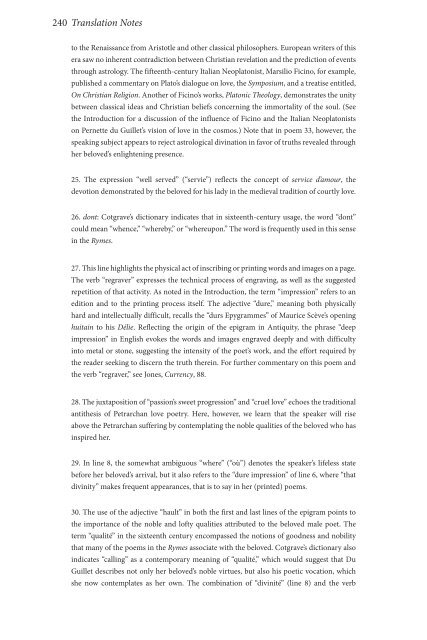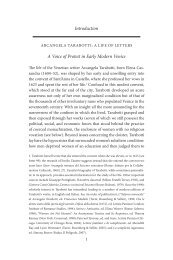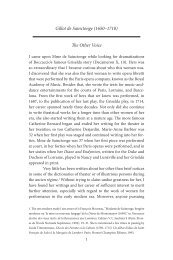Excerpt - Iter: Gateway to the Middle Ages and Renaissance
Excerpt - Iter: Gateway to the Middle Ages and Renaissance
Excerpt - Iter: Gateway to the Middle Ages and Renaissance
You also want an ePaper? Increase the reach of your titles
YUMPU automatically turns print PDFs into web optimized ePapers that Google loves.
240 Translation Notes<br />
<strong>to</strong> <strong>the</strong> <strong>Renaissance</strong> from Aris<strong>to</strong>tle <strong>and</strong> o<strong>the</strong>r classical philosophers. European writers of this<br />
era saw no inherent contradiction between Christian revelation <strong>and</strong> <strong>the</strong> prediction of events<br />
through astrology. The fifteenth-century Italian Neopla<strong>to</strong>nist, Marsilio Ficino, for example,<br />
published a commentary on Pla<strong>to</strong>’s dialogue on love, <strong>the</strong> Symposium, <strong>and</strong> a treatise entitled,<br />
On Christian Religion. Ano<strong>the</strong>r of Ficino’s works, Pla<strong>to</strong>nic Theology, demonstrates <strong>the</strong> unity<br />
between classical ideas <strong>and</strong> Christian beliefs concerning <strong>the</strong> immortality of <strong>the</strong> soul. (See<br />
<strong>the</strong> Introduction for a discussion of <strong>the</strong> influence of Ficino <strong>and</strong> <strong>the</strong> Italian Neopla<strong>to</strong>nists<br />
on Pernette du Guillet’s vision of love in <strong>the</strong> cosmos.) Note that in poem 33, however, <strong>the</strong><br />
speaking subject appears <strong>to</strong> reject astrological divination in favor of truths revealed through<br />
her beloved’s enlightening presence.<br />
25. The expression “well served” (“servie”) reflects <strong>the</strong> concept of service d’amour, <strong>the</strong><br />
devotion demonstrated by <strong>the</strong> beloved for his lady in <strong>the</strong> medieval tradition of courtly love.<br />
26. dont: Cotgrave’s dictionary indicates that in sixteenth-century usage, <strong>the</strong> word “dont”<br />
could mean “whence,” “whereby,” or “whereupon.” The word is frequently used in this sense<br />
in <strong>the</strong> Rymes.<br />
27. This line highlights <strong>the</strong> physical act of inscribing or printing words <strong>and</strong> images on a page.<br />
The verb “regraver” expresses <strong>the</strong> technical process of engraving, as well as <strong>the</strong> suggested<br />
repetition of that activity. As noted in <strong>the</strong> Introduction, <strong>the</strong> term “impression” refers <strong>to</strong> an<br />
edition <strong>and</strong> <strong>to</strong> <strong>the</strong> printing process itself. The adjective “dure,” meaning both physically<br />
hard <strong>and</strong> intellectually difficult, recalls <strong>the</strong> “durs Epygrammes” of Maurice Scève’s opening<br />
huitain <strong>to</strong> his Délie. Reflecting <strong>the</strong> origin of <strong>the</strong> epigram in Antiquity, <strong>the</strong> phrase “deep<br />
impression” in English evokes <strong>the</strong> words <strong>and</strong> images engraved deeply <strong>and</strong> with difficulty<br />
in<strong>to</strong> metal or s<strong>to</strong>ne, suggesting <strong>the</strong> intensity of <strong>the</strong> poet’s work, <strong>and</strong> <strong>the</strong> effort required by<br />
<strong>the</strong> reader seeking <strong>to</strong> discern <strong>the</strong> truth <strong>the</strong>rein. For fur<strong>the</strong>r commentary on this poem <strong>and</strong><br />
<strong>the</strong> verb “regraver,” see Jones, Currency, 88.<br />
28. The juxtaposition of “passion’s sweet progression” <strong>and</strong> “cruel love” echoes <strong>the</strong> traditional<br />
anti<strong>the</strong>sis of Petrarchan love poetry. Here, however, we learn that <strong>the</strong> speaker will rise<br />
above <strong>the</strong> Petrarchan suffering by contemplating <strong>the</strong> noble qualities of <strong>the</strong> beloved who has<br />
inspired her.<br />
29. In line 8, <strong>the</strong> somewhat ambiguous “where” (“où”) denotes <strong>the</strong> speaker’s lifeless state<br />
before her beloved’s arrival, but it also refers <strong>to</strong> <strong>the</strong> “dure impression” of line 6, where “that<br />
divinity” makes frequent appearances, that is <strong>to</strong> say in her (printed) poems.<br />
30. The use of <strong>the</strong> adjective “hault” in both <strong>the</strong> first <strong>and</strong> last lines of <strong>the</strong> epigram points <strong>to</strong><br />
<strong>the</strong> importance of <strong>the</strong> noble <strong>and</strong> lofty qualities attributed <strong>to</strong> <strong>the</strong> beloved male poet. The<br />
term “qualité” in <strong>the</strong> sixteenth century encompassed <strong>the</strong> notions of goodness <strong>and</strong> nobility<br />
that many of <strong>the</strong> poems in <strong>the</strong> Rymes associate with <strong>the</strong> beloved. Cotgrave’s dictionary also<br />
indicates “calling” as a contemporary meaning of “qualité,” which would suggest that Du<br />
Guillet describes not only her beloved’s noble virtues, but also his poetic vocation, which<br />
she now contemplates as her own. The combination of “divinité” (line 8) <strong>and</strong> <strong>the</strong> verb




